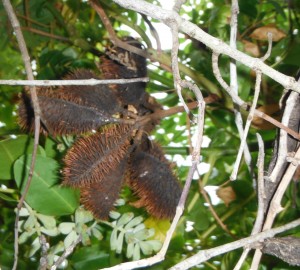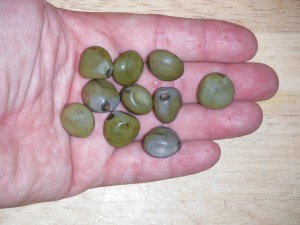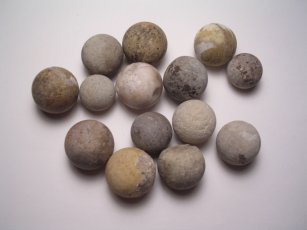My youngest daughter, Emily, has been talking about “hot beans” for a couple months now, and has been wanting to show me a “trick” you can do with them. Being a practical joker myself, I looked forward to whatever she was going to show me. And while the trick itself is very minor, it does have some interesting potential, and is memorable enough to be worth writing about.

Stopping at Indian Riverside Park in Jensen Beach, we walked down to the shore, Emily making a bee-line to the tree/vine/shrub. As soon as she pointed out the seed pods, I recognized it as something I’ve seen before, but one just another of the multitude of plants that grow in Florida that was unfamiliar to me.
A thorny, climbing vine with prickled brown seed pods, the seeds are one of many floating seeds referred to as “Sea beans”, and are the center of my daughter’s trick.
I had a picture of it, and doing my typical over-researching, I found them to be “Sea Pearls”, “Nickernuts” or “Nicker beans”. The variety I was shown are the Gray Nickarbean.
From “Beach Beans.com:
I also found this at seabean,com :
Old English name for marble? It seems they were named back when marbles were made from baked clay. It’s close, but the folks who named them must either be blind, or possibly just bad marble makers. And if they thought these looked like sea pearls…they need a new jeweler!
I was happy to have identified the plant. I also went over to Green Dean’s website to check if I could eat it. No such luck, other than medicinally.
I did find that they are used as Mancala game pieces, as well as for many crafts, since they polish well, and last a long time due to their hard outer shell. Other than paracord bracelets, I’m not much for jewelry either. At least I had a parlor trick left!
The trick itself is simple enough, take one of these beans, rub it on a rough surface, such as denim pants or a rock, for a couple of seconds, then touch it to the bare skin of the target person. It becomes very hot to the touch, and seems to burn, rather shockingly considering the minimal amount of effort applied. Nothing that harms you, but it definitely scares you at first.
In it’s simplicity, it’s a wonderful thing, something along the lines of getting someone to eat an Indian Turnip back in the hills of West Virginia, or taking someone “snipe hunting“, only NOT the game bird. It made me wonder how I didn’t know about it, but my kids did. Then I realized that the childhood that Shawn & I talked about a while back is exactly what my kids are experiencing right now- growing up in Florida, with all of the local lessons, experiences, and tricks.
I wonder if one of them will one day write a blog called “The West Virginia Cracker” ??
Peace,
db
Notes:
Seabean info: http://www.seabean.com/
Nickernut info: http://waynesword.palomar.edu/nicker.htm

